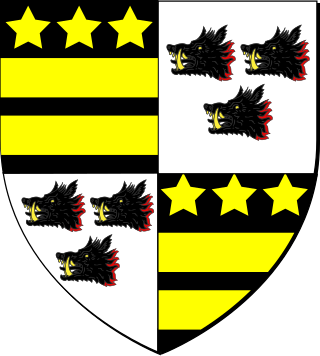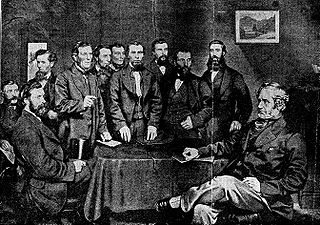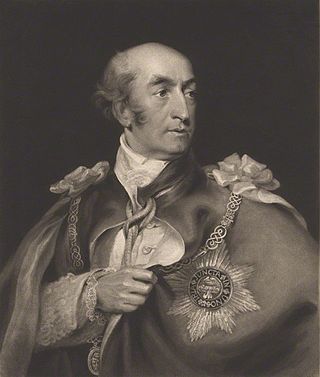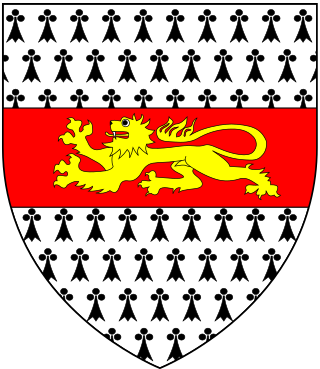Related Research Articles

George Nugent-Temple-Grenville, 1st Marquess of Buckingham, was a British statesman.

Marquess Conyngham, of the County of Donegal, is a title in the Peerage of Ireland. It was created in 1816 for Henry Conyngham, 1st Earl Conyngham. He was the great-nephew of another Henry Conyngham, 1st Earl Conyngham, a member of a family of Scottish descent which had settled during the Plantation of Ulster in County Donegal in Ireland in the early 17th century. The 'founder' of the dynasty in Ireland was The Very Rev. Dr. Alexander Cunningham, Dean of Raphoe. The earlier Henry was a member of both the Irish House of Commons and the British House of Commons and served as Vice-Admiral of Ulster and as Governor of the counties of Donegal and Londonderry. In 1753 he was raised to the Peerage of Ireland as Baron Conyngham, of Mount Charles in the County of Donegal, and in 1756 he was created Viscount Conyngham, in Ireland, also in the Peerage of Ireland. In 1781 he was made Baron Conyngham, of Mount Charles in the County of Donegal, with remainder to his nephew Francis Burton, and Earl Conyngham, of Mount Charles in the County of Donegal, which like the creations of 1753 and 1756 was created with normal remainder to the heirs male of his body. The latter titles were also in the Peerage of Ireland. Lord Conyngham was childless and on his death in 1781 the barony of 1753, the viscountcy and earldom became extinct while he was succeeded in the barony of 1781 according to the special remainder by his aforementioned nephew Francis. He was the eldest son of Mary, sister of the first Earl Conyngham, by her husband Francis Burton. The new 2nd Baron Conyngham, who had earlier represented Killybegs and County Clare in the Irish House of Commons, assumed by Royal licence the surname and arms of Conyngham on succeeding to the titles.

Earl of Powis (Powys) is a title that has been created three times. The first creation came in the Peerage of England in 1674 in favour of William Herbert, 3rd Baron Powis, a descendant of William Herbert, 1st Earl of Pembroke. In 1687, he was further honoured when he was made Marquess of Powis.

Earl of Donoughmore is a title in the Peerage of Ireland. It is associated with the Hely-Hutchinson family. Paternally of Gaelic Irish descent with the original name of Ó hÉalaighthe, their ancestors had long lived in the County Cork area as allies of the Mac Cárthaigh clan; they lost out during the times of Oliver Cromwell. One branch of the family converted to the Anglican Church and after inheriting territories through his mother and adding "Hutchinson" to Hely, became the Earl of Donoughmore.

Baron Walsingham, of Walsingham in the County of Norfolk, is a title in the Peerage of Great Britain.
Baron Kensington is a title that has been created three times, in the Peerages of England, Ireland and the United Kingdom.

Baron Carbery, of Carbery in the County of Cork, is a title in the Peerage of Ireland. It was created in 1715 for George Evans, with remainder to the heirs male of his father and namesake George Evans, a supporter of William and Mary during the Glorious Revolution, who had earlier declined the offer of a peerage. After his elevation to the peerage Lord Carbery represented Westbury in the House of Commons. He was succeeded by his eldest son, the second Baron. He also sat as Member of Parliament for Westbury. His grandson, the fourth Baron, briefly represented Rutland in Parliament. He was succeeded by his uncle, the fifth Baron. On his death the line of the eldest son of the first Baron failed. He was succeeded by his first cousin once removed, the sixth Baron, who had previously succeeded his father as second Baronet, of Castle Freke. Lord Carbery sat in the House of Lords as an Irish Representative Peer from 1824 to 1845. His nephew, the eighth Baron, was an Irish Representative Peer from 1891 to 1894. As of 2014 the titles are held by the latter's great-great-grandson, the twelfth Baron, who succeeded his father in 2012.

Baron Glanusk, of Glanusk Park in the County of Brecknock, is a title in the Peerage of the United Kingdom. It was created in 1899 for Sir Joseph Bailey, 2nd Baronet, who had earlier represented Herefordshire and Hereford in the House of Commons as a Conservative. Both his son, the second Baron, and grandson, the third Baron, served as Lord Lieutenant of Brecknockshire. The latter was succeeded by his first cousin, the fourth Baron. He was the son of the Hon. Herbert Crawshay Bailey, fourth son of the first Baron. As of 2010 the titles are held by his son, the fifth Baron, who succeeded in 1997.

Baron Penrhyn is a title that has been created twice. The first creation came in the Peerage of Ireland in 1783 in favour of Richard Pennant, who had previously served as a Member of Parliament for Petersfield and Liverpool. This creation became extinct on his death in 1808. The next creation came in 1866 in the Peerage of the United Kingdom when the Conservative politician Edward Douglas-Pennant was created Baron Penrhyn, of Llandegai in the County of Carnarvon. He had previously represented Carnarvon in the House of Commons and also served as Lord Lieutenant of Caernarvonshire. He was granted the estate of his father-in-law on the condition that he accepted his wife's maiden name, Pennant. Lord Penrhyn was the younger brother of The 17th Earl of Morton. In 1833 he had married Juliana Isabella Mary Pennant, eldest daughter and co-heiress of George Hay Dawkins-Pennant of Penrhyn Castle and in 1841 he assumed by Royal licence the additional surname of Pennant.
Nathaniel Clements, 2nd Earl of Leitrim, KP PC (Ire), styled The Honourable from 1783 to 1795, and then Viscount Clements to 1804, was an Irish nobleman and politician.

Bernard Arthur William Patrick Hastings Forbes, 8th Earl of Granard,, styled Viscount Forbes from 1874 to 1889, was an Anglo-Irish soldier and Liberal politician.

Earl of Lanesborough was a title in the Peerage of Ireland. It was created in 1756 for Humphrey Butler, 2nd Viscount Lanesborough. The Butler family descended from Theophilus Butler, who represented County Cavan and Belturbet in the Irish House of Commons. In 1715 he was raised to the Peerage of Ireland as Baron Newtown-Butler, of the County of Fermanagh, with remainder to the heirs male of his father. He was succeeded according to the special remainder by his brother, Brinsley, the second Baron. He had previously represented Kells and Belturbet in the Irish Parliament. In 1728 he was created Viscount Lanesborough in the Peerage of Ireland. He was succeeded by his son, Humphrey, the aforementioned second Viscount, who was elevated to an earldom in 1756. The first Earl was succeeded by his son, Brinsley, the second Earl. He represented County Cavan in the Irish House of Commons. His grandson, the fifth Earl, sat in the British House of Lords as an Irish Representative Peer from 1849 to 1866. The latter was succeeded by his nephew, the sixth Earl. He served as Lord-Lieutenant of Cavan from 1876 to 1900 and was an Irish Representative Peer from 1870 to 1905. He was succeeded by his son, the seventh Earl. He was an Irish Representative Peer from 1913 to 1929. On his death the titles passed to his younger brother, the eighth Earl. The titles became extinct on the death of the latter's eldest son, the ninth Earl, in December 1998.

John Blaquiere, 1st Baron de Blaquiere, KCB, PC, known as Sir John Blaquiere, Bt. from 1784 to 1800, was a British soldier, diplomat and politician of French descent. He served as Chief Secretary for Ireland between 1772 and 1776

John Joshua Proby, 1st Earl of Carysfort, KP, PC, PC (Ire), FRS was a British judge, diplomat, Whig politician and poet.
General Robert Cuninghame, 1st Baron Rossmore, PC (Ire) was an Irish British Army officer and politician.
Baron Riversdale, of Rathcormuck in the County of Cork, was a title in the Peerage of Ireland. It was created on 13 October 1783 for William Tonson, who had earlier represented Rathcormack and Tuam in the Irish House of Commons. His eighth son, the third Baron, was Bishop of Killaloe and Clonfert. The title became extinct on his death in 1861. The Tonson family descended from Benjamin Tonson, Treasurer of the Navy during the reign of Queen Elizabeth I. His descendant Richard Tonson was granted lands in Ireland for his services during the English Civil War and settled at Spanish Island, County Cork. His grandson Richard Tonson was a member of the Irish Parliament for Baltimore for many years. The latter's only son was the aforementioned William Tonson who was elevated to the peerage in 1783.
Thomas Knox, 1st Earl of Ranfurly, styled The Honourable Thomas Knox between 1781 and 1818 and known as The Viscount Northland between 1818 and 1831, was an Irish peer and politician.

Thomas de Grey, 2nd Baron Walsingham PC, was a British politician who sat in the House of Commons from 1774 to 1781 when he succeeded to the peerage as Baron Walsingham. He served as Joint Postmaster General and was for many years Chairman of Committees in the House of Lords.
Ludlow Tonson, 3rd Baron Riversdale, was a Church of Ireland bishop.
Warner William Westenra, 2nd Baron Rossmore, was an Anglo-Irish landowner and politician.